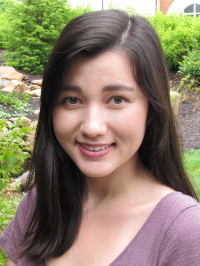2019 NIMBioS-NSA REU Program Participant Profile:
Cassandra Azeredo-Tseng
 |
Hometown: Worcester, MA
|
Why did you apply to the SRE program?
Using mathematical models to study biological systems was a field that intersected my two passions. I found NIMBioS provided the perfect opportunity to gain collaborative experience, which I appreciate since most of this type of work has been independent at my small-sized school.
![]()
Even though we are helpfully guided by mentors, they give us the chance to make mistakes and find our intuition in navigating unanswered questions.
![]()
– Cassandra Azeredo-Tseng, SRE participant
What is the purpose of your research?
In the project, we are studying cancer associated epithelial to mesenchymal transition (EMT), but specifically the early dynamics of these epithelial cells. The EMT process describes how cells physically change to become more mobile, allowing travel throughout the body. By analyzing data, we can better our base model to predict the observed behavior of epithelial cells when they are prone to cancer.
Describe a typical day on the job.
Each day we work around eight hours on different components of the project. We will either meet in NIMBioS' office or other on campus student-study areas. Our team also meets with our mentors at least three times a week to plan objectives and monitor progress. Initially, we work separately and then join our work together for cohesive understanding, but rely on each other more for discussion and problem-solving through issues in the project.
Tell us something about your field of study we would be surprised to know.
There are a lot of biological data collected for singular use, and repurposing data for mathematical modeling takes great creativity. Especially in interdisciplinary work, it takes unique thought to fit others' work to be useful for your particular interest.
What were your favorite parts of the SRE program?
The community here has been amazingly supportive. I have a great time conversing with mentors and other students in the program. We all have different, exciting backgrounds, and with this SRE as a common interest, the research becomes dynamic and fun. The atmosphere is definitely my favorite because it has made the challenging research even more enjoyable.
What new experiences did you gain that have helped you today?
I have learned to practice seeing the steps to the bigger picture. Oftentimes, each task in research requires a specific focus and it can be easy to forget how it ties into the end goal. Even though we are helpfully guided by mentors, they give us the chance to make mistakes and find our intuition in navigating unanswered questions.
What advice would you give someone who's interested in/curious about participating in the program?
Not only does this SRE program help develop your research skills, it provides a realistic view on what it means to be collaborative. Each member in the team offers a distinct perspective and strength, and learning to use these differences can greatly benefit the project. So, make sure to be open to varying views and you will get to think in a lot of new ways.
Would you recommend our program to others?
Yes, especially to those who have had little to no research experience. This place is very supportive by helping fill holes in your background through tutorials and connecting you with people in the fields you're interested in.
NIMBioS
1122 Volunteer Blvd., Suite 106
University of Tennessee
Knoxville,
TN 37996-3410
PH: (865) 974-9334
FAX: (865) 974-9461
Contact NIMBioS


